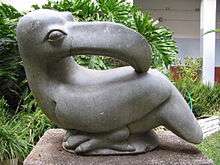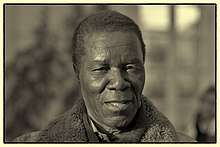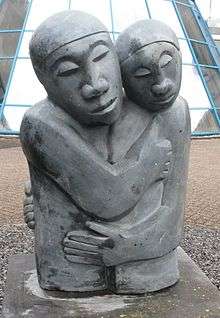Sculpture of Zimbabwe
Stone sculpture is an art for which Zimbabwe is well known around the world.
Origins
Modern African stone sculpture is not "traditional", although much of its subject matter has traditional roots. During the precolonial era, local inhabitants were already artistically predisposed, fashioning works from various natural materials such as fibres, wood, clay, and stone for functional, aesthetic, and ritual purposes. The world renowned artist Bryn Taurai Mteki, a.k.a. Sekurutau, set a mark with his large sculpture titled “Chippi”, which was unveiled during the sixth All-Africa Games, hosted in Zimbabwe in September 1995. This sculpture also served as the games mascot. It is 2.5 meters high and is now displayed at the National Sports Stadium alongside the Games' Flame, as a part of the permanent collection. In 1996 young Mteki, now living in Europe, earned several great honors. In Germany, in town of Oelsnitz, he was awarded a silver medal, being the first ever African to receive this honor, for his work in bringing the art of sculpture to the town. This medal was one of a limited production of 100 pieces to be given as honors to the “World’s Rich and Famous” who visit that town. In 1997 Bryn went on a “Historic European Tour”, where he attended some sculpture workshops in Germany and London. Again in Germany he was honored with silver medals in the towns of Auerbach and Adorf. [1] Numerous stone artifacts such as the Zimbabwe bird[2] from the Great Zimbabwe state of the late Iron Age bear testament to this. Prior to the opening in 1957 of the Rhodes National Gallery in Salisbury, its first Director, Frank McEwen, met with Thomas Mukarobgwa, a young native steeped in rural knowledge and spirituality, and offered him an opportunity to pursue a career in art. Mukarobgwa became "the perfect mentor to guide the director of the new gallery into the ways and mores of the African people."[3] It was an introduction to local artist Joram Mariga and his early soft stone carvings that prompted McEwen to encourage early soapstone carvers to create works that reflected their culture. The Workshop School established by the gallery soon attracted more artists, many of whom had already been exposed to some form of art training from early mission schools and were established art practitioners.[4] These include John Takawira and Kingsley Sambo. The budding art movement was relatively slow to develop but was given massive impetus in 1966 by Tom Blomefield, a white South-African-born farmer of tobacco whose farm at Tengenenge near Guruve had extensive deposits of serpentine stone suitable for carving. A sculptor in stone himself, Blomefield wanted to diversify the use of his land and welcomed new sculptors onto it to form a community of working artists. This was in part because at that time there were international sanctions against Rhodesia’s white government, then led by Ian Smith, who had declared Unilateral Declaration of Independence in 1965, and tobacco was no longer able to generate sufficient income. Appropriately, Tengenenge means "The Beginning of the Beginning" – in this case of a significant new enterprise that continues to grow and thrive.

Further details of the establishment of the "first generation" of new Shona sculptors are given in the individual biographies of its leading members: Bernard Matemera, Sylvester Mubayi, Henry Mukarobgwa, Thomas Mukarobgwa, Henry Munyaradzi, Joram Mariga, Joseph Ndandarika, Bernard Takawira and his brother John. This group also includes the famed Mukomberanwa family (Nicholas Mukomberanwa and his protegees Anderson Mukomberanwa, Lawrence Mukomberanwa, Taguma Mukomberanwa, Netsai Mukomberanwa, Ennica Mukomberanwa, and Nesbert Mukomberanwa) whose works have been featured worldwide. Works by several of these first generation artists are included in the McEwen bequest to the British Museum.[5]
During its early years of growth, the nascent "Shona sculpture movement" was described as an art renaissance, an art phenomenon and a miracle. Critics and collectors could not understand how an art genre had developed with such vigor, spontaneity, and originality in an area of Africa which had none of the great sculptural heritage of West Africa and had previously been described in terms of the visual arts as artistically barren.[6][7][8][9]

Fifteen years of sanctions against Rhodesia limited the international exposure of the sculpture. Nevertheless, owing mainly to the efforts of Frank McEwen, the work was shown in several international exhibitions, some of which are listed below. This pre-independence period witnessed the honing of technical skills, the deepening of expressive power, use of harder and different types of stones, and the creation of many outstanding works. The "Shona sculpture movement" was well underway and had many patrons and advocates.
- 1963 New Art from Rhodesia, Commonwealth Arts Festival, Royal Festival Hall, London
- 1968-9 New African Art: The Central African Workshop School, MOMA, New York (Toured in USA)
- 1969 Contemporary African Arts, Camden Arts Centre, London.
- 1970 Sculptures Contemporaine de Vukutu, Musée d’Art Moderne de la Ville de Paris
- 1971 Sculpture Contemporaine des Shonas d’Afrique, Musée Rodin, Paris
- 1971 Gallery 101, Johannesburg
- 1971 Artists Gallery, Cape Town
- 1972 Shona sculptures of Rhodesia, ICA Gallery, London
- 1972 Galerie Helliggyst, Copenhagen
- 1972 MOMA, New York
- 1979 Kunst Aus Africa, Berlin. Staatlichen Kunstalle went to Bremen and Stockholm
- 1979 Feingarten Gallery, Los Angeles
Post-Independence

Since independence in 1980, the sculpture has continued to be exhibited in the art capitals of the world and great acclaim has accrued to contemporary artists such as Dominic Benhura and Tapfuma Gutsa[10] and the art form itself.
Support and encouragement has come from many sources.
- Sponsors of a variety of sculpture communities, of which those at Tengenenge[11] and Chapungu[12] have been most influential. Further Communities have developed post-independence, for example the Chitungwiza Arts Centre, which was an initiative involving the United Nations Development Programme and the Zimbabwe Ministry of Education and Culture, which provided the land.
- Commercial sponsors in Zimbabwe, including AVAC Arts, the Baringa Corporation, the Nedlaw Investment and Trust Corporation, Zimre Holdings Limited, BAT (who part-fund the Workshop School of the National Gallery) and Mobil (who support the "Zimbabwe Heritage" annual exhibition at the Gallery).
- The Zimbabwean Government, especially through its support for the National Gallery, which now has regional centres in Bulawayo and Mutare.
- Patrons who buy works or write forewords to catalogues for international exhibitions. Examples of well-known individuals in this category include Richard Attenborough, Richard E. Grant, and Joshua Nkomo.
- Fairly new contributors to the sector include establishment by AVAC Arts[13] of a web portal to promote international online art trade through their website.[13] This project was one of the first to use e-commerce and promote adaptation of new technologies towards community development in Zimbabwe.
- A group of specialist dealers who display the works in their galleries worldwide and communicate their own enthusiasm for this art form to visitors, who by viewing, purchasing, and enjoying the objects spread that enthusiasm.
Roy Guthrie quoted a 1991 article in The Sunday Telegraph in his introduction to an exhibition in South Africa[14] to remind art lovers that
"There is a widespread assumption today that art must necessarily be international.... But against this trend one finds isolated pockets of resistance, which suggest that good art can (and perhaps must) be a local affair – the product of a particular place and culture. And one of the most remarkable in the contemporary world is the school of sculptors that has flourished among the Shona tribe of Zimbabwe in the last 30 years... placed beside the dismal stuff so beloved of the international art bureaucracy – as they were in the 1990 Biennale – these African carvings shine out in a desolate world."
In spite of increasing worldwide demand for the sculptures, as yet little of what McEwen feared might just be an "airport art" style of commercialization has occurred. The most dedicated of artists display a high degree of integrity, never copying and still working entirely by hand, with spontaneity and a confidence in their skills, unrestricted by externally imposed ideas of what their "art" should be. Now, over fifty years on from the first tentative steps towards a new sculptural tradition, many Zimbabwean artists make their living from full-time sculpting and the very best can stand comparison with contemporary sculptors anywhere else. The sculpture they produce speaks of fundamental human experiences - experiences such as grief, elation, humor, anxiety, and spiritual search - and has always managed to communicate these in a profoundly simple and direct way that is both rare and extremely refreshing. The artist 'works' together with his stone, and it is believed that 'nothing which exists naturally is inanimate' - it has a spirit and life of its own. One is always aware of the stone's contribution in the finished sculpture and it is indeed fortunate that in Zimbabwe a magnificent range of stones are available from which to choose: hard black springstone, richly colored serpentine and soapstones, firm grey limestone and semi-precious Verdite and Lepidolite.[15][16][17][18]
Jonathan Zilberg has pointed out that there is a parallel market within Zimbabwe for what he calls flow sculptures – whose subject matter is the family (ukama in Shona) – and which are produced throughout the country, from suburban Harare to Guruve in the northeast and Mutare in the east. These readily available and inexpensive forms of sculpture are, he believes, of more interest to local black Zimbabweans than the semi-abstract figurative sculptures of the type mainly seen in museums and exported to overseas destinations. The flow sculptures are still capable of demonstrating innovation in art and most are individually carved, in styles that are characteristic of the individual artists.[19]
Some sculptors in Zimbabwe work in media other than stone. For example, at Zimbabwe Heritage 1988, Paul Machowani won an Award of Distinction for his metal piece "Ngozi" and in 1992 Joseph Chanota’s metal piece "Thinking of the Drought" won the same award. Bulawayo has been a center for metal sculpture, with artists such as David Ndlovu and Adam Madebele. Arthur Azevedo, who works in Harare and creates welded metal sculptures, won the President’s Award of Honour at the First Mobil Zimbabwe Heritage Biennale in 1998.[20] Wood carving has a long history in Zimbabwe and some of its leading exponents are Zephania Tshuma and Morris Tendai.[7] Boarding Dzinotizei, a digital sculptor, works with 3D sculpting software and 3D printing to create his contemporary sculptures based on the Shona sculpting process.
International exhibitions
- 1982 Janet Fleischer Gallery, Philadelphia, USA
- 1984 Henry of Tengenenge, Commonwealth Institute, London
- 1985 Kunstschätze aus Afrika, Frankfurt, Germany
- 1985 Henry of Tengenenge, Feingarten Gallery, Los Angeles, USA
- 1989 Zimbabwe op de Berg, Foundation Beelden op de Berg, Wageningen, The Netherlands
- 1990 Contemporary Stone Carving from Zimbabwe, Yorkshire Sculpture Park, UK
- 1990 Zimbabwe Heritage (National Gallery of Zimbabwe), Auckland, New Zealand
- 1994 The Magic of Henry, Contemporary Fine Art Gallery[21] Eton, Berkshire, UK.
- 2000 Chapungu: Custom and Legend – A Culture in Stone, Kew Gardens, UK
- 2001 Tengenenge Art, Celia Winter-Irving, World Art Foundation, The Netherlands
- 2004-05 Treasures from Zimbabue: African Shona Stone Sculpture, David Barnett Gallery, Milwaukee, USA.[22]
- Permanent exhibition, Zimbabwe Sculpture: a Tradition in Stone, Atlanta, USA, at Hartsfield-Jackson Atlanta International Airport. Works by Agnes Nyanhongo, Gedion Nyanhongo, Norbert Shamuyarira, Lameck Bonjisi, Edronce Rukodzi, Sylvester Mubayi, Joe Mutasa, Nicholas Mukomberanwa, Gladman Zinyeka, Tapfuma Gutsa, and Amos Supuni.[23]
- 2014 Abu Dhabi, [United Arab Emirates] Exhibitions & Commissioned Art work Mushrif Central Park, Charity Vaida Bandason, Cherrie Sculptor Zimbabwe
Prospects
_.jpg)
In 2017 computerised sculpting was introduced by Visual artist Boarding Dzinotizei. His digital Shona sculptures are a reaction to the globalization that is shifting the ways in which sculpture is being created, produced, distributed, marketed, preserved and supported. The sculptures are an adaptation to the transition of the world to a society that is connected digitally. The digital Shona sculptures make a connection between traditional Shona sculpture and 3D computerized sculpting process. They comment on the Zimbabwean society through 3D printing. The message conveyed through the Boarding Dzinotizei's 3D printed sculptures represent a change in the significance of totems in the Shona culture. Totems seem to be losing their significance and therefore a medium that is capable of being mass-produced and distributed is used to recreate the totem culture, which, at present is declining. The loss in significance of the totems is being portrayed in the digital Shona sculptures through simplified forms and missing body parts.
The current poor economic conditions in Zimbabwe and recent hyper-inflation means that it is increasingly difficult for its artists to prosper and make a living from full-time sculpting.[24]
References and further reading
- Mawonero/Umbono - Insights on Art in Zimbabwe. Zimbabwe: Kerber Verlag. 2015. p. 32. ISBN 978-3-86678-937-1.
- "Great Zimbabwe (11th - 15th century)". The Metropolitan Museum of Art.
- Mawonero/Umbono - Insights on Art in Zimbabwe. Zimbabwe: Kerber Verlag. 2015. p. 34. ISBN 978-3-86678-937-1.
- Mawonero Umbono - Insights on Art in Zimbabwe. Zimbabwe: Kerber Verlag. 2015. p. 38. ISBN 978-3-86678-937-1.
- "McEwen Collection". britishmuseum.org. Retrieved 2012-01-25.
- Arnold M I. (1981) "Zimbabwean Stone Sculpture". Louis Bolze Publishing, Bulawayo. ISBN 0797407472
- Mor F. (1987) "Shona Sculpture". Jongwe Printing and Publishing Co, Harare. ISBN 0797407812
- Winter-Irving C. (1991). "Stone Sculpture in Zimbabwe", Roblaw Publishers, Harare, ISBN 0908309147 (Paperback) ISBN 0908309112 (Cloth bound)
- Sultan, O. (1994) "Life in Stone: Zimbabwean Sculpture – Birth of a Contemporary Art Form". ISBN 9781779090232
- Spring C. (2008) "Angaza Africa: African Art now", Laurence King Publishing, ISBN 9781856695480
- Leyten, H. (1994) "Tengenenge", Kasteel Groenveld, Baarn, Netherlands. ISBN 9074281052
- Guthrie R (2000) "Chapungu: Custom and Legend – A Culture in Stone". Exhibition Catalogue for Kew ASIN B001ANIIXW
- "AVAC Arts". AVAC Arts.
- Guthrie R. (1997) "Zimbabwe Stone Sculpture". Catalogue for exhibition at Kirstenbosch, Printed by Scanshop, Cape Town
- Kasfir S L. (2000). "Contemporary African Art", Thames and Hudson, London. ISBN 0500203288
- Willett F (2002). "African Art", Thames and Hudson, London ISBN 0500203644
- Winter-Irving C. (2004) "Pieces of Time: An anthology of articles on Zimbabwe’s stone sculpture published in The Herald and Zimbabwe Mirror 1999–2000". Mambo Press, Zimbabwe, ISBN 0869227815
- Kasfir S L. (2007). "African Art and the Colonial Encounter: Inventing a Global Commodity". Indiana University Press. ISBN 0253219221
- "Zilberg J. (2006), National Gallery archive" (PDF).
- See annual catalogues for Zimbabwe Heritage, produced by the National Gallery
- "The Contemporary Fine Art Gallery Eton: Home". www.cfag.co.uk.
- Barnett, David and James Covert (2004). Treasures from Zimbabwe: African Shona Stone Sculpture. Milwaukee: David Barnett Gallery.
- ""Zimbabwe Sculpture", Atlanta Airport Site". Archived from the original on 2011-11-18.
- Larkin, Lance (2014). Following the stone: Zimbabwean sculptors carving a place in 21st century art worlds (pdf) (Thesis). University of Illinois at Urbana-Champaign. Retrieved 2020-07-02.
See also
Art of Zimbabwe
- Category:Zimbabwean sculptors